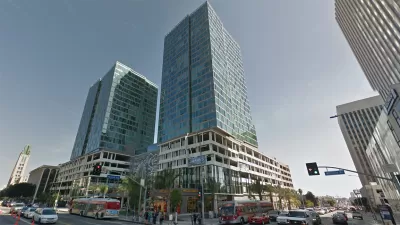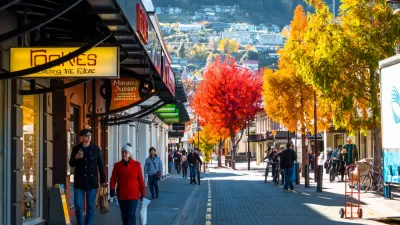Thom Mayne proposes a radical solution to Los Angeles' affordability/preservation problem: build up transit-friendly areas far beyond current densities, and leave the rest unchanged.

Long touted as a city of reinvention, Los Angeles faces some serious challenges putting that reputation to the test. Architect Thom Mayne asks, "How can we absorb an additional 1.5 million people while accounting for the impacts of climate change, advancing environmental sustainability (100% local water, 100% renewable energy, and enhanced ecosystem and human health) and urban affordability without completely destroying the character that Angelenos love about their city?"
His answer? "By adding 1 million more people along the Wilshire Boulevard corridor (which already has a half million people, for a total 1.5 million) and another half million in other transit-oriented areas." Meanwhile, anti-development Angelenos could continue their low-rise lifestyle everywhere else.
In the near-term at least, this project sounds politically unfeasible. But Mayne is thinking big: "In fact, using Hong Kong's residential building types, [the Wilshire corridor] could accommodate another 8 million people. In our relatively conservative model, the density of the Wilshire corridor would be less than that of Manhattan."
This vision is a tale of two cities: transit-oriented high-rise LA and auto-friendly suburban LA. In a more modest fashion, the city may already be heading in that direction. Mayne's plan fully embraces that future. From the article: "The strategy also diminishes water demand from single-family lawns, reduces vehicular emissions associated with sprawl, and protects an area 10 times its size —150,000 acres — that would have to be developed to meet housing demand at L.A.'s current densities. By building upward instead of outward, the corridor could easily create 70% more public open space for stormwater capture, habitat, and heat diffusion."
FULL STORY: Adding 1 million people along the Wilshire corridor could help L.A. create a sustainable city

Pennsylvania Mall Conversion Bill Passes House
If passed, the bill would promote the adaptive reuse of defunct commercial buildings.

Coming Soon to Ohio: The Largest Agrivoltaic Farm in the US
The ambitious 6,000-acre project will combine an 800-watt solar farm with crop and livestock production.

World's Largest Wildlife Overpass In the Works in Los Angeles County
Caltrans will soon close half of the 101 Freeway in order to continue construction of the Wallis Annenberg Wildlife Crossing near Agoura Hills in Los Angeles County.

California Grid Runs on 100% Renewable Energy for Over 9 Hours
The state’s energy grid was entirely powered by clean energy for some portion of the day on 37 out of the last 45 days.

New Forecasting Tool Aims to Reduce Heat-Related Deaths
Two federal agencies launched a new, easy-to-use, color-coded heat warning system that combines meteorological and medical risk factors.

AI Traffic Management Comes to Dallas-Fort Worth
Several Texas cities are using an AI-powered platform called NoTraffic to help manage traffic signals to increase safety and improve traffic flow.
City of Costa Mesa
Licking County
Barrett Planning Group LLC
HUD's Office of Policy Development and Research
Mpact Transit + Community
HUD's Office of Policy Development and Research
Tufts University, Department of Urban and Environmental Policy & Planning
City of Universal City TX
ULI Northwest Arkansas
Urban Design for Planners 1: Software Tools
This six-course series explores essential urban design concepts using open source software and equips planners with the tools they need to participate fully in the urban design process.
Planning for Universal Design
Learn the tools for implementing Universal Design in planning regulations.


























